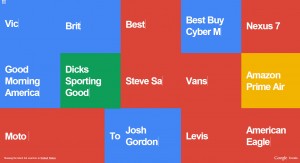Following the long Thanksgiving weekend, The Hunger Games: Catching Fire raked in an additional $110.1 million over the Wednesday-to-Sunday period to bring it’s worldwide total to over $573 million. These record setting numbers don’t necessarily stick around only at the box office, the popularity of these blockbusters result in subsequent conversation online across all different channels – and mediums.
Beloved PBS program Sesame Street recently gets my recent vote for relevance. Yes, the same big yellow bird that first aired months after Neil Armstrong’s walk on the moon in 1969 is continuing to wow audiences (young and old) while staying relevant in pop culture. The key is sticking to your product or service and not deviating from what your audience expects from you. The method of presentation and subject matter however, can be left up to your interpretation.
The key is sticking to your product or service and not deviating from what your audience expects from you.
The “Hungry Games – Catching Fur” aired as a parody starring everyone’s favorite, Cookie Monster Cookieness Evereat in late November to coincide with the Catching Fire November 22nd release. Whether or not you had seen the first of the series or were new to Suzanne Collins’ trilogy, Sesame Street found a way to stick with what they know (teaching children) by introducing patterns in their own version of the flick’s grueling challenges. Of course, for me, they also garnered a number of laughs.
A local video blogging group, Simple Pickup received more subscribers in the month of October for their ‘motorboat’ campaign to coincide with Breast Cancer Awareness month. While their efforts were later thwarted and donation refunded, their method of staying relevant around the subject matter and executing in a creative manner landed them a viral story and received attention that ultimately led visitors to their product lines. Their model works and now their latest video on their channel depicts a pickup-line technique based solely on Miley Cyrus’ catchy lyrics.
Though at times controversial, South Park Studios has been successfully executing this model since their inception. When 60 Minutes went behind the scenes with the creators at their Culver City, CA studios in 2011, their audience had an opportunity to get a glimpse at what a six-day turnaround required to produce their episodes. While you may not have as stringent a timeline where millions of fans are curious how Kenny will weekly be decapitated, having the foresight to plan content around trends has become more necessary than ever.
While working in Higher Education, presenting statistics and figures for varying topics was certainly not as ‘sexy’ as the entertainment industry. However, by staying true to who we were, pairing certain topics with conversations from professors yielded our most engaging content. During early spring when the NCAA March Madness tournament was gearing up, we planned a series of posts with our Quantitative Analytics Centers to draw parallels between performance and brands for each of the top-ranked Division-I programs. The Emory Business Sports Marketing Professors’ blog posts when timed with a major trending event, proved to be our best site drivers and most shared content.
Whether you’re a company without a head of content, or running your own social strategy, spending time to work out a content calendar around some more topical matters can not only continue to bring your audience to return to your site/blog/twitter, it provides exposure for new targets. Including #Bieber in every tweet won’t solve your SEO woes, but careful research to your geographic targets and industry-specific topics will typically show increased audience engagement.
Including #Bieber in every tweet won’t solve your SEO woes.
Tools for Planning
The easiest means to figure out what your targets are talking about and to provide valuable fodder to add to the conversation, is looking at trends. A number of services have placed more importance on the real-time mapping of online searches and trends.

Google Trends – starting from the world’s search #1 seems most logical. Their Visual Trends makes a great screensaver for that third monitor you never use, but also visually updates in real-time all of the top searches and conversations and provides filters for language and region. Look at the grave differences between the United States and Asia
http://www.google.com/trends/hottrends
What the Trend – Oldie but a goodie. You enter in a hashtag, it tells you why folks are yammering.

Trendsmap – Real-time local twitter trends. Based on a zoomable map that will disclose trends all the way down to county-level within a state.
http://trendsmap.com/
Start with a regular 12-month calendar and write everything that comes to mind. Sure the holidays are coming up in December, but what about February and Oscar Season? For a clothing manufacturer discussing the top red carpet styles is obvious, but what about someone who works in NPO’s discussing the charities for example nominated actors and directors are a part of. Being creative and thinking beyond the face of a topic will not only provide lasting and relevant content, but assist in ensuring your brand progresses with the trends as well.
Looking to hire a content marketer or interested in finding out more about success metrics? Visit BizCommunity.com’s latest: Content Marketing: Get a Head (of content)


